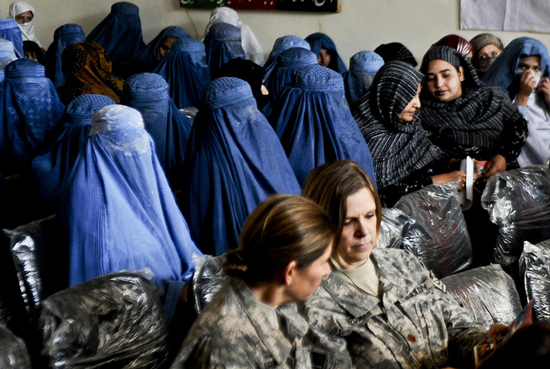The original version of this article, by Eric Zuehlke, appeared on the Population Reference Bureau’s Behind the Numbers blog.Recent media reports have focused on the stalled progress for women in Afghanistan and the shift in the international community’s focus as they take steps towards an eventual military withdrawl. Although there’s much work to be done, it’s important to note that there has been tangible improvement for
women in Afghanistan. A decade ago, women weren’t allowed to go out in public alone. Girls weren’t allowed to attend school – now
57 percent of girls are in school. And gender issues are now being integrated into government policy.
At an Interagency Gender Working Group (IGWG) Plenary in honor of 2011 International Women’s Day hosted by PATH in Washington DC, Karen Hardee, a senior fellow at PRB and president of Hardee Associates, presented her involvement towards developing the National Gender Strategy for the Afghanistan Ministry of Public Health for 2011-2015. Much international development program and policy advocacy calls for attention to “gender,” but what does the term mean? “Gender isn’t just about women,” said Hardee, but is defined as the social roles that men and women play because of the way society is organized. But these roles aren’t set in stone; they can change over time.
Funded by USAID, the Health Services Support Project worked with the Afghan government to create a plan to integrate gender considerations into all public health programs and policies, focusing mostly on mental health and gender-based violence. Interestingly, the impetus of the process stemmed the initiative of a male official in the Ministry of Public Health who requested assistance to write a plan to integrate gender into the Ministry’s policies and programs. Having participated in WHO-sponsored gender training workshops in the past, he understood the importance of mainstreaming gender awareness for both men and women. It’s a great example of the tangible effects of the work being done on gender by NGOs and international donors.
Continue reading on Behind the Numbers.
Sources: The Guardian.
Photo Credit: “PRT, ADT women help celebrate Women’s Day in Kunar,” courtesy of flickr user DVIDSHUB.

 A Publication of the Stimson Center.
A Publication of the Stimson Center.







